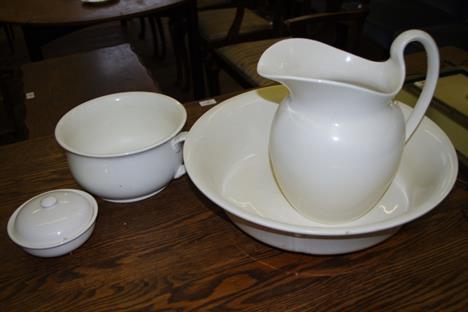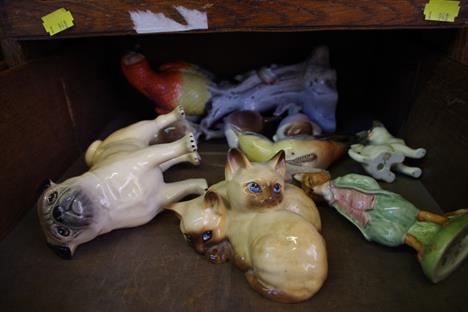We found 163691 price guide item(s) matching your search
There are 163691 lots that match your search criteria. Subscribe now to get instant access to the full price guide service.
Click here to subscribe- List
- Grid
-
163691 item(s)/page
THE RODNEY JUG. AN HISTORIC DERBY MASK JUG brilliantly painted by Edward Withers with magnificent groups of extensive flowers, the bust of the Admiral also finely enamelled within laurels, dated in gold below "April the 12th 1782", within a gilt dentil rim, the handle and footrim also gilt, 25cm h, painted crowned D in puce, c1782-83, exhibition label inscribed in ink "Miss Ward" Exhibited: Derby, The Midland Counties Fine Arts and Industrial Exhibition 1870 (No 74 Case A). Provenance: Made for the `Loyal Club` a Derby Friendly Society (founded in 1777, dissolved in 1862 or `63). Bought from the Society for£2 in 1862 or `63 by a former member, Mr Ward by whom bequeathed to his brother, a Derby tailor (the exhibition label on the jug is inscribed in ink Miss Ward). Acquired by Mr Ratcliffe of Walton Hall near Burton on Trent, Staffordshire prior to 1876. Literature: Wallis (Alfred) and William Bemrose, The Pottery and Porcelain of Derbyshire, 1870. The present jug is illustrated in an original photograph (albumen print) pasted into Wallis` own Grangerised copy (F70V), (Derbyshire Record Office, Matlock). Wallis & Bemrose`s slim work was published to coincide with, and serve as, a guide to the Exhibition. Haslem (John), The Old Derby China Factory, 1876, pp202-4. Twitchett (John), Derby Porcelain, 1980, pp285-6. Mitchell (S), The Marks on Chelsea-Derby, 2007, pp77-99 and plt A. The re-emergence of this, the original Derby `Rodney Jug` in 2005, was a major ceramic rediscovery of the progenitor of a famous 18th c English porcelain form. The history of the jug is fully described by Haslem (Literature), but may be summarised as follows: The jug was first published by John Haslem in two letters to the Derby Mercury in 1861 and May 1866, written in reply to a correspondent. It was made for the use of the `Loyal Club`, many members of which, including Edward Withers, were painters at the Derby factory as well as jewellers and related tradesmen. The Club met monthly at several Derby inns where the jug was used for serving ale during a period of about 80 years. Haslem observes, apparently without irony, that the jug`s survival "speaks favourably of the general sobriety of the members", that when not in use it was hung from a nail in the wall and "to this may be ascribed a little scratching of the glaze..." He continues "on each removal of the Club to fresh quarters, the safety of the old Rodney" as the jug was affectionately called, was a prime consideration with the members, and it was generally intrusted to the care of Mundy Simpson, one of the painters, to whom it would almost have been death, without the benefit of clergy, had the precious relic come to grief..." The basic form, derived from a Meissen model, was made in three sizes (of which the present jug is the largest) and with various decoration. Only a very small number (judging by their rarity), perhaps less than 5, or 10 at most, are commemorative. These are similarly inscribed and boldly painted by Withers. Despite, or perhaps because of, their rarity some confusion has arisen as to which jug was the `original`, exacerbated by the long disappearance of the present jug. In particular, that once in the Bemrose Collection was mis-catalogued (T Neale & Son of Nottingham, auctioneers) when sold in 1909 (1-5 March 1909, lot 319), as is proved when the illustration in the sale catalogue is compared with the photograph in Wallis (Literature). At a London sale held by Mr Phillips in 1871, Haslem himself corrected the auctioneer pointing out that the example about to be sold was not the one "used until lately by a club of Derby china painters (see Chaffers)", to quote from the catalogue. The Bemrose sale - one of the finest collections of English porcelain, especially Derby - to be sold around 1900 was formed by Alfred Wallis` co-author. Interestingly, Bemrose`s `Rodney jug` made the highest price in the sale -£117.12.0 (Amor) which makes for an interesting comparison with the red anchor period Chelsea life-sized boar`s head tureen, that sold for£105. In the same Sale, a slightly smaller `Rodney jug` sold for£63 and is now in the Schreiber Collection (Victoria and Albert Museum). Edward Withers worked first at the Chelsea factory before moving to Derby when Duesbury took it over in 1770. He left, and returned at least once. During his absence he worked in London, Staffordshire and for a japanner in Birmingham. He died at Derby. The Admiral, George Brydges, 1st Baron Rodney (1719-1792) routed the superior Franco-Spanish fleet in a famous naval Victory off Dominica in the West Indies, on the date commemorated by the jug. He accepted the surrender of the French Admiral, the Comte de Grasse. In fine condition; no restoration
THREE RARE PLYMOUTH MUGS of baluster shape and graduated in size, brilliantly enamelled by Soquoi with `Fancy Birds` in a continuous landscape beneath a gilt looped line border, 10.5-15cm h, painted alchemical sign for tin in red enamel or gilt, collector`s label [or part thereof], c1768-70 Provenance: Trapnell Collection (No 609); purchased with the rest of Trapnell`s Plymouth and Bristol porcelain by Albert Amor in 1912 and by whom sold ("A set of three Plymouth mugs, very richly and brilliantly decorated with exotic birds and foliage") to A S Hitchins of St Austell for£170; thence by descent to the previous owner. Literature: Trapnell (A), A Catalogue of Bristol and Plymouth Porcelain... forming the Collection made by Mr Alfred Trapnell, London: A Amor, 1912, No 609; Transactions of the English Ceramic Circle vol II, no 9, 1946, plt LXX(A); Mackenna (F S), Cookworthy`s Plymouth and Bristol Porcelain, Leigh-on-Sea 1947, fig 7; The F S Mackenna Collection of English Porcelain Part III, Leigh-on-Sea 1975, p116, Sotheby & Co, anon sale, 17 Oct 1967, lot 300. These fine Plymouth mugs were once part of the highly important collection of English porcelain, especially rich in Plymouth and Bristol formed by Alfred Trapnell. According to The Times, the value of the 1000 or so pieces of Trapnell`s porcelain bought by Amor was almost£15,000, a staggering sum even by the standards of the day when the prices of the best 18th century English porcelain were near their peak. Amor had it transported to London by rail and thence to his St James`s shop in a horse-drawn vehicle with newly patented pneumatic wheels and under armed guard (source www.albertamor.co.uk) The distinctive painting of `Fancy` or exotic birds on Plymouth and some early Bristol porcelains has long been associated with the enigmatic `Mons Soquoi`, a painter who joined William Cookworthy`s small factory in January 1769. It has been suggested that he may be identified as Michel Soquet, a French painter working at Vincennes in 1752 and also at Sèvres between 1756-1764 and again from 1773-74. He was employed at Plymouth to develop painting in enamels and gilding, requiring a room to himself according to a letter written by Cookworthy in 1769. `Soquoi` commanded the high wage of 24 shillings (£2) a week. At least two other hands have been identified as painting in this style and similar Plymouth wares were painted at the London atelier of the independent decorator, James Giles. Sold with Albert Amor receipt dated April 1, 1912. In fine condition, no wear etc, no restoration
Arts and Crafts table lamp pyramidal hammered copper Unusual Arts and Crafts table lamp, pyramidal hammered copper over mica shade with a stylized tree and owl design supported by a Chinese influenced ceramic column on a copper base, 15"w x 15"d x 17"h minor flaking to mica; dirty original patina
Amphora ewer Amphora ewer, large shape with raised leaves and a handle of stems in gold over a cream matte glaze, marked, #3853, 7"w x 14.5"h; with an Amphora vase, designed by Paul Dachsel, Terex secessionist vase with lilies and band of ceramic jewels at bottom, silver matte glaze with gold highlights, marked, 5"w x 9"h, Terex was a special Wahliss series of Paul Dachsel designs (1)minor wear; a little dirty; impressed marks on base; overall very good condition/(2)no problems; a little dirty; impressed logo on base; overall very good condition
Otto Eckman vase Otto Eckman vase, monumental ceramic form covered in a mottled red and blue glaze, housed in a double handled bronze mount, French, c. 1895, signed, 11.5"w x 20.5"h, restoration to top restoration to top; minor crazing and minor surface scratches; impressed initials in bronze
Clyde Burt ceramic wall sculpture Clyde Burt ceramic wall sculpture, rectangular composition in stoneware covered in earth tone glazes, incised signature "C Burt", mounted in the original wood frame, includes an original Clyde Burt flier advertising the 57th Street Art Fair which includes a bio and illustrates a similar work, ceramic only: 9"w x 19.75"h, framed size: 15"w x 26"h, excellent original condition Mint condition. No chips or cracks. No repairs. Original frame. Currently hanging vertically, although the orientation of the signature suggests that it may have been designed to hang horizontally. Provenance: the estate of a Chicago artist.
Harris Strong wall hanging Harris Strong wall hanging, ceramic, multi-colored glazed tiles with red and orange hues form a cityscape mounted on a walnut veneered board, 48.75"w x 24.75"h, excellent original condition No water rings or stains. No chips or cracks. No repairs. Sturdy and structurally sound. No problems with tiles or wood.
-
163691 item(s)/page



























































